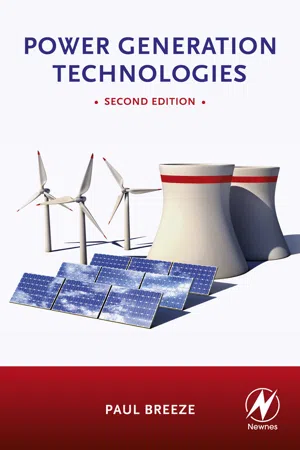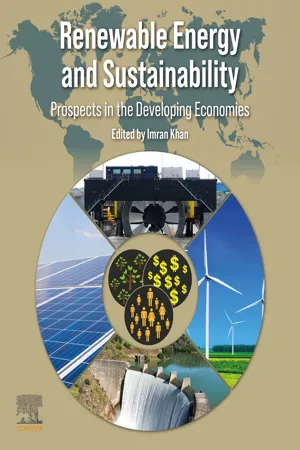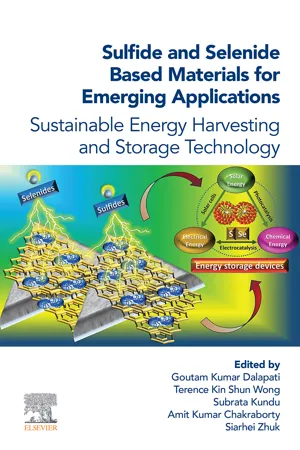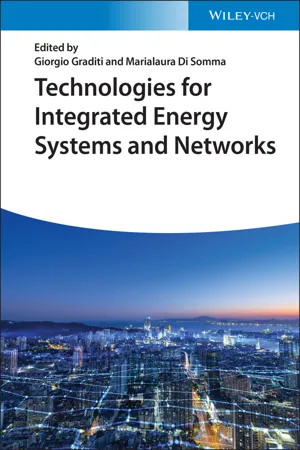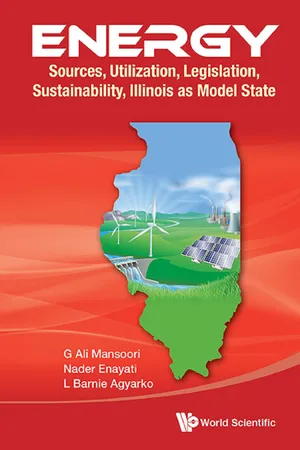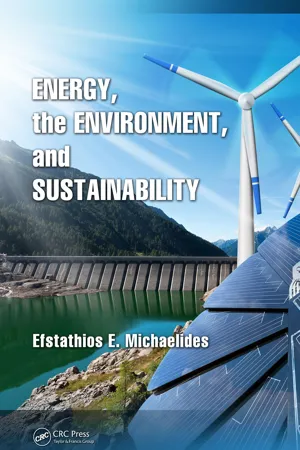Geography
Energy Storage Technologies
Energy storage technologies refer to various methods and systems used to store energy for later use. These technologies include batteries, pumped hydro storage, compressed air energy storage, flywheels, and thermal energy storage. They play a crucial role in supporting the integration of renewable energy sources, managing peak demand, and enhancing grid stability and reliability.
Written by Perlego with AI-assistance
Related key terms
Related key terms
1 of 4
Related key terms
1 of 3
11 Key excerpts on "Energy Storage Technologies"
- eBook - ePub
- Paul Breeze(Author)
- 2014(Publication Date)
- Newnes(Publisher)
Chapter 10Power System Energy Storage Technologies
Abstract
Electrical energy storage can play an important role in electricity supply by storing off-peak energy for delivery in periods of peak demand and by helping to stabilize the generation from intermittent resources such as wind and solar power. Analysis suggests that for optimum grid stability, 15% of capacity should be based on energy storage. However, the storage of electricity has proved difficult to master. The main large-scale Energy Storage Technologies are pumped storage hydropower, compressed-air energy storage, and, at the lower capacity range, batteries. For smaller-scale storage supercapacitors and flywheels can be used and small superconducting magnetic energy storage rings have been used in some grid stability applications. Pumped storage hydropower accounts for most of the capacity already in place and much of this was built to support nuclear-generating capacity. There is interest today in energy helping the integration of intermittent renewable capacity.Keywords pumped storage hydropower compressed-air energy storage supercapacitors flywheels battery storage redox battery superconducting magnetic energy storage energy arbitrage renewable integrationEnergy storage plays a vital part in the modern global economy. At a national level, oil and gas are regularly stored by both utilities and governments, while at a smaller scale petrol stations store gasoline and all cars carry a storage tank to provide them with the ability to travel a significant distance between refueling stops. Domestic storage of hot water is also usual in modern homes. Yet when it comes to electrical energy, storage on anything but a small scale in batteries is rare.Part of the reason for this is that storage of electricity, although it can be achieved in a number of ways, is difficult. In most storage technologies the electricity must be converted into some other form of energy before it can be stored. For example, in a battery it is converted into chemical energy, while in a pumped storage hydropower plant the electrical energy is turned into the potential energy contained within an elevated mass of water. Energy conversion makes the storage process complex and the conversion itself is often inefficient. These and other factors help to make an energy storage system costly. - eBook - ePub
Renewable Energy and Sustainability
Prospects in the Developing Economies
- Imran Khan(Author)
- 2022(Publication Date)
- Elsevier(Publisher)
Chapter 13The role of Energy Storage Technologies for sustainability in developing countries
Md Momtazur Rahmana , Imran Khanb , Kamal Alamehaa School of Science, Edith Cowan University, Joondalup Drive, WA, Australiab Department of Electrical and Electronic Engineering, Jashore University of Science and Technology, Jashore, Bangladesh13.1 Introduction
Since the Industrial Revolution, the foundation of the world's economic growth has been dependent on the widespread access to affordable, reliable and modern energy. For a sustainable future, the required energy must be generated from sustainable energy sources, such as solar, geothermal and wind (Magda et al., 2020 ), which are more compatible with environmental sustainability (Nguyen and Pham, 2020 ). However, solar and wind energy-based systems require back-up energy generating facilities due to their inherent intermittent nature (Walawalkar et al., 2007 ). These back-up generating facilities, such as energy storage systems can significantly add flexibility to the renewable energy systems by minimizing the fluctuating nature of solar and wind (Arif et al., 2013 ). In contrast, nonrenewable resources are limited in supply and cannot be used sustainably (Armaroli and Balzani, 2011 ). Therefore, renewable energy, particularly solar-based systems, have become a widespread energy generation option in both developed and developing countries.Electric grids are often highly unreliable in remote areas due to a shortage of generation capacity and other transmission and distribution issues (Levin and Thomas, 2016 ). Energy storage can help match variable renewable energy supplies to meet the peak electricity demand by storing solar energy during the day and releasing it at night, thus saving money due to storing excess energy. However, the increasing amounts of variable renewable energy penetration, such as solar and wind energy types could negatively impact the energy security process. Therefore, developing countries require a new approach to reliably and cost-effectively manage demand variability and uncertainty (IEA, 2019 - eBook - ePub
- Paul Breeze(Author)
- 2019(Publication Date)
- Newnes(Publisher)
Chapter 10Power System Energy Storage Technologies
Abstract
Electrical energy storage can play an important role in electricity supply by storing off-peak energy for delivery in periods of peak demand and by helping to stabilise the generation from intermittent resources such as wind and solar power. Analysis suggests that for optimum grid stability, 15% of capacity should be based on energy storage. However, the storage of electricity has proved difficult to master. The main large-scale Energy Storage Technologies are pumped-storage hydropower, compressed air energy storage and at the lower capacity range, batteries. For smaller scale storage, supercapacitors and flywheels can be used and small superconducting magnetic energy storage rings have been used in some grid stability applications. Pumped-storage hydropower accounts for most of the capacity already in place and much of this was built to support nuclear generating capacity. There is interest today in energy storage to help the integration of intermittent renewable capacity.Keywords
Pumped-storage hydropower; compressed air energy storage; supercapacitors; flywheels; battery storage; redox battery; superconducting magnetic energy storage; energy arbitrage; renewable integrationEnergy storage plays a vital part in the modern global economy. At a national level oil and gas are regularly stored by both utilities and by governments, while at a smaller scale petrol stations store gasoline and all cars carry a storage tank to provide them with the ability to travel a significant distance between refuelling stops. Domestic storage of hot water is also usual in modern homes. Yet when it comes to electrical energy, storage on anything but a small scale, in batteries, is rare.Part of the reason for this is that the storage of electricity, although it can be achieved in a number of ways, is difficult. In most storage technologies the electricity must be converted into some other form of energy before it can be stored. For example, in a battery, it is converted into chemical energy while in a pumped-storage hydropower plant the electrical energy is turned into the potential energy contained within an elevated mass of water. Energy conversion makes the storage process complex and the conversion itself is often inefficient. These and other factors help to make an energy storage system costly. - eBook - ePub
Storage and Scarcity
New practices for food, energy and water
- Giorgio Osti(Author)
- 2016(Publication Date)
- Routledge(Publisher)
socio-technical network. Furthermore, there is a special linkage with the growth of renewable sources of energy: their intermittence requires complementary use of storage devices. Hydro power – the most widespread renewable – usually needs an upstream accumulation basin. Finally, energy storage entails more leeway for the final consumer, which modifies the relationship with grid energy suppliers used to being able to drive the demand side with ease. At first glance, energy storage is a way to sever the link with a network; in fact, off-grid storage systems allow self-sufficient provision of energy for a building, a block or an island. Indeed, the most interesting situations are where there is a mix of energy self-provision, storage and exchange with a grid, in similar ways to food and water storage.4.1 The issueTechnically, an ‘energy storage system [ESS] means commercially available technology that is capable of absorbing energy, storing it for a period of time, and thereafter dispatching the energy’ (Malashenko et al. 2012: 4). This definition has three analytical components: the temporal phases, storage of energy using mechanical, chemical or thermal processes, and availability on the market, which means public accessibility as long as there is money to purchase energy. The market rule also means the possibility of legal possession of storage devices by private subjects. This last point is important in terms of relationships: whereas energy provision and connection imply compliance with a wide array of public rules, energy storage is a freer activity that underlines the final user’s autonomy.There are numerous techniques for storing energy (see Table 4.1 ), although there is a hierarchy in terms of use and maturity. There are natural settings and artificial arrangements in which energy is present in potential form or is expressed in terms of movement/work; the storage of energy refers to the former. The processes for storing energy are usually classified according to how materials or combinations of them can be used to accumulate and then release energy. Hence there are mechanical methods able to discharge movement when necessary, thermal methods able to release heat or cold when needed, and chemical methods with which to isolate substances able to supply thermal or kinetic energy at the appropriate time. Electrical and electrochemical methods use electricity processes combined with certain qualities of materials to accumulate and then deliver electrical energy directly. Finally, biological methods - M. Kathiresh, A. Mahaboob Subahani, G. R. Kanagachidambaresan, M. Kathiresh, A. Mahaboob Subahani, G. R. Kanagachidambaresan(Authors)
- 2021(Publication Date)
- Wiley-Scrivener(Publisher)
6 Grid Energy Storage TechnologiesChandra Sekhar NalamatiElectrical Engineering Department, Motilal Nehru National Institute of Technology Allahabad, Prayagraj, IndiaAbstractEver increasing world energy consumption, limited global resources for tradition fossil fuel–based power supply networks, deregulated world energy markets, and global environmental concerns have been changed the global energy landscape from centralized power network to green renewable energy integrated distributed power network. Green clean renewable energy sources include solar photovoltaics, wind turbine based, combined heat and power (CHP), micro turbines, and fuel cells system. By 2040, the world will more rely on solar and wind supplies that are together expected to increase their share three times in the global energy. The complementary pattern regimes of the wind and solar PV sources coupled with the energy storage technology support makes them firm energy source. Energy Storage Technologies help in reducing power generation-consumption gap and also in improving grid power quality and stability. Most of the Energy Storage Technologies are deep-rooted. Also, the advances in material and processing technologies and bulk production result in reduction of cost. The specific energy storage technology has been chosen based on need of power density, energy density, and cost for different durations (short-term or long-term) and applications.The main objective of this chapter is to acquaint with overview on various grid electrical Energy Storage Technologies with their detailed characteristics comparison and their applications.Keywords: Grid energy storage, renewable power generation and smart grid6.1 Introduction
The traditional power supply system has been characterized by non-distributed power generation plants, one-way power flow direction from generation to the customers, fossil fuel–based generation, and passive nature. The world population and its growing energy demand generation, concerns regarding environmental pollution of fossil fuel–based power generations, and need of other power generation resources to fulfill the current energy demand have changed the conventional power system paradigm to a new structure. The possible ways to balance the generation and demand are installation of new power generation plants with corresponding transmission, distribution system, and using customer side demand response approaches and adding energy storage with green energy sources. However, first two solutions are not feasible due to economic issues and time-to-time dealing with customers. The viable solution for new power system structure allows the environmental friendly renewable energy resources integration along with the electrical energy storage system to help to fulfill the need of rising energy demand and growing environmental concerns. However, the environmental friendly renewable energy sources (RES) availability depends on their geographical location and also they are uncontrollable in nature. The electrical energy storage systems help RES to improve their efficient usage and make them better power sources [1–7]. Figure 6.1- eBook - ePub
Sulfide and Selenide Based Materials for Emerging Applications
Sustainable Energy Harvesting and Storage Technology
- Goutam Kumar Dalapati, Terence Kin Shun Wong, Subrata Kundu, Amit Kumar Chakraborty, Siarhei Zhuk(Authors)
- 2022(Publication Date)
- Elsevier(Publisher)
Chapter 3Introduction to various sustainable Energy Storage Technologies
Gopalan Saiananda # , Anantha-Iyengar Gopalanb d # , K. Venkatramananc , Dong-Eun Leeb d , Prashant Sonare f ga Global Center for Environmental Remediation (GCER), College of Engineering, Science and Environment, The University of Newcastle, Callaghan 2308, NSW, Australiab Intelligent Construction Automation Center, Kyungpook National University, Daegu, Koreac Department of Physics, SCSVMV Deemed University, Kanchipuram, Indiad School of Architecture, Civil, Environment and Energy Engineering, Kyungpook National University, Daegu, Koreae School of Chemistry and Physics, Queensland University of Technology, QLD, Australiaf Centre for Materials Science, Queensland University of Technology, QLD, Australiag Centre for Clean Energy and Practices, Queensland University of Technology, QLD, Australia# Authors contributed equally to this work.Chapter Outline
- 3.1 Energy and its importance 33
- 3.1.1 Fossil, renewable and sustainable energy 34
- 3.1.2 Need for storage of energy 35
- 3.2 Energy storage (ES) technologies 36
- 3.2.1 Mechanical energy storage 37
- 3.2.2 Electrical energy storage (EES) systems 41
- 3.2.3 Thermal energy storage system (TES) 43
- 3.2.4 Chemical energy storage (CES) 46
- 3.3 Comparison of characteristics of storage technologies 49
- 3.3.1 Comparison in terms of power density and energy density 49
- 3.3.2 Comparison of ESS in terms of life expectancy and efficiency of energy 50
- 3.3.3 Comparison in terms of investment cost 50
- 3.3.4 Comparison in terms of specific power and energy 51
- 3.3.5 Salient features of comparison 51
- 3.4 Integration of energy storage systems 52
- 3.5 Conclusion 53
- References 53
3.1 Energy and its importance
Energy, by definition, is the capacity for doing or performing work. It may exist in potential, kinetic, thermal, electrical, chemical, nuclear, or other various forms, The many forms of energy can be categorized into two main headings; potential energy and kinetic energy. Potential energy is the stored energy in an object/material due to its position with respect to some zero position. Chemical, mechanical, nuclear, and gravitational are a few of the forms of potential energy. On the other hand, kinetic energy is the form of energy that an object, particle waves, electrons, atoms, molecules, substances, and objects can have by its motion. Radiation, thermal, motion, sound, and electrical are some of the potential energy forms. The use of energy can be identified in at least the four economic sectors: residential, commercial, transportation, and industrial. The industrial revolution as well the daily life needs make the use of energy become insatiable. It is hard to imagine a time when the role of energy is not a part of our lives. Due to the increasing need and importance, energy has consistently become one of the world's most concerning issues and a key factor to be considered in worldwide development. - eBook - ePub
- Shady S. Refaat, Omar Ellabban, Sertac Bayhan, Haitham Abu-Rub, Frede Blaabjerg, Miroslav M. Begovic(Authors)
- 2021(Publication Date)
- Wiley-IEEE Press(Publisher)
IRENA estimates that pumped storage hydropower will rise from 169.557 to 325 GW in 2030. Over the same time period, the available battery electrical storage will rise up to 1.6 GW, [18]. Energy storage is an essential means for allowing an effective implementation of RES and revealing the advantages of SGs. This technology repeatedly proves its worth to grid operators worldwide, moreover, the fast‐decreasing costs and improving capabilities of ESSs technologies, along with growing industry expertise, will swiftly introduce new markets and cost‐effective applications for energy storage [19]. Figure 4.5 Global Grid‐Connected Energy Storage Capacity, by Technology, 2018. 4.5 Techno‐Economic Characteristics of Energy Storage Systems Different Energy Storage Technologies have different applications in the energy system. Capacity, cost, energy density, efficiency level, and technical and economic life are factors that determine in which context the technologies are the most suitable. A number of Energy Storage Technologies are now available in the market and each one of them offers a variety of performance parameters. The key performance parameters for evaluating Energy Storage Technologies are discussed in this section [ 20 – 28 ]. Figure 4.6 demonstrates an overview of Energy Storage Technologies with respect to their relative discharge times, power scale in the order of MW, and their respective efficiencies. Systems located at the right side of Figure 4.6 (shows a relatively high discharge time and energy storage capacity) demonstrate similarities to PHS and CAES, in terms of how perfect they are for product storage, arbitrage, rapid reserve, and area control‐frequency responsive reserve. Systems located on the left side of Figure 4.6 (high power to energy ratio and low discharge time requirements), for instance, flywheels, SCs, and SMES, are applicable for power quality‐reliability and transmission system stability implementations - Giorgio Graditi, Marialaura Di Somma(Authors)
- 2022(Publication Date)
- Wiley-VCH(Publisher)
This has led to immense reductions in cost and improvements in system efficiency, and this is expected to continue in the near‐term future. Despite these improvements, there still needs to be further development in this sector. This can be done through a combination of deployment led innovation and active policies and regulation, which shape research and development [3]. The breadth of energy storage applications is rapidly accelerating and is shown in the emerging sector of hybrid or multi‐energy systems. These are systems that combine various renewable energies, traditional energy sources, and storage systems, which complement each other to develop energy systems that take advantages of each of the component systems [2]. Within multi‐energy systems, Energy Storage Technologies can be applied at nearly all scales and time frames [4]. Each of the different Energy Storage Technologies has its own advantages and disadvantages, and the exact combination of technologies for a given application should be carefully studied to ensure that the full potential of energy storage systems in multi‐energy systems is harnessed [5]. This chapter introduces the concept of energy storage and discusses the various types of energy storage systems. Recent projects using energy storage systems are highlighted to show the diversity of applications of energy storage systems. Then, the concept of multi‐energy systems is discussed briefly, with a detailed focus on the application of Energy Storage Technologies to multi‐energy systems. 5.2 Energy Storage In the energy system, an important component is energy storage- eBook - ePub
Energy: Sources, Utilization, Legislation, Sustainability, Illinois As Model State
Sources, Utilization, Legislation, Sustainability, Illinois as Model State
- Nader Enayati, L Barnie Agyarko, G Ali Mansoori(Authors)
- 2015(Publication Date)
- WSPC(Publisher)
Energy storage can provide substantial benefit to energy users, especially in cases where energy source is subjected to variation or intermittency. It is reported that in the U.S., not more than 20% of the electricity demand can be provided by intermittent renewable without energy storage (Cavallo, 2001). The concept of energy storage and its success are based on the principle that it should be more cost effective to store energy from one time than to produce it later, when it is needed (Hyman, 2011). In other words, the cost of energy storage must be cheaper when it is stored than the value of energy when it is recovered. The difference must be big enough to cover the cost of investment, maintenance, operation and energy losses.Table 11.7. Capital cost and efficiencies of the various energy storage systems.(1) EPRI (2010); (2) Hauer (2013); (3) Zuberbühler (2010); (4) IRENA (2012); (5) Carnegie et al. (2013) N/A = not available.Energy storage systems are not just storage facilities since their operation requires application of energy. For example, in CAES system the air is compressed and heated (to prevent freezing of water vapor) and then, electricity is generated through expansion of heated air in expanders (Safaei et al., 2013). Such expenditure of energy requires energy storage systems to be economically and environmentally sustainable.Energy storage systems can be applied on small or large scales in distributed or centralized systems and while some storage technologies are mature or in demonstration phase, most are still in early stages of development, as shown in Table 11.8 .Table 11.8. Status of Energy Storage Technologies (IEA, 2014a).Com: Commercialization stage; R&D: Research and Development stage; Demo: Demonstration stage.As discussed in Secs. 11.2 and 11.3, there are varieties of Energy Storage Technologies, but PHS, CAES and BESS are more suitable for bulk energy storage systems. A study conducted by the Electric Power Research Institute (EPRI, 2010), showed that underground compressed air energy storage technology is the most cost effective when compared with other Energy Storage Technologies such as PHS, BESS, or flywheel. Their result also showed that for CAES, location of the storage reservoir is very crucial in cost ($/kWh) of the technology and an aboveground system is six times more expensive than the underground system. - eBook - ePub
Power Electronics in Renewable Energy Systems and Smart Grid
Technology and Applications
- Bimal K. Bose(Author)
- 2019(Publication Date)
- Wiley-IEEE Press(Publisher)
82 ].Figure 10.3 Classification of Energy Storage Technologies based on the storage methodology.10.3.1 Mechanical Energy Storage
Mechanical storage exchanges its stored energy with the power grid in the form of kinetic or potential energy. The most common mechanical storage technologies are pumped hydroelectric power plants (pumped hydro‐storage: PHS), compressed air energy storage (CAES) and flywheel energy storage (FES) [83 ].Pumped Hydro‐Storage (PHS)
Pumped hydro is the most mature mechanical energy storage technology. The first pumped hydro‐storage plants were installed in the Alpine regions of Switzerland, Austria and Italy in the 1890s. PHS has a long history as a well‐established centralized power generation technology and is commercially available on a large scale. All existing pumped storage facilities in the world involve surface reservoirs, either natural or artificial, and a small number use very large water bodies [84 ].At present, pumped hydro systems are the most widely used energy storage technology, and represents more than 96% of worldwide bulk storage capacity. As depicted in Figure 10.4 , a typical conventional PHS plant uses two water reservoirs at different elevations to pump water mostly during off‐peak hours from the lower to the upper reservoir. This charging operation mode (pumping mode) uses surplus (or cheap) electrical energy to store energy in the form of gravitational potential energy. At a later time, when energy is required, the water flows back down from the upper to the lower reservoir, powering a turbine that drives the electrical machine to generate electricity. This discharging operation mode (generation/turbine mode) uses the stored potential energy to convert it back into electrical energy, just like a conventional hydroelectric power facility [85 ]. The amount of energy stored depends on the height difference between the two reservoirs and the total volume of water stored. In the same way, the rated power of PHS plants depends on the water pressure and flow rate through the turbines, and rated power of the pump/turbine and generator/motor units. Due to the low energy density of pumped storage schemes, they are actually only applicable for large‐scale grid applications [86 - eBook - ePub
- Efstathios E. Michaelides(Author)
- 2018(Publication Date)
- CRC Press(Publisher)
With the impending depletion of fossil fuels and the apparent realization of the climatic effects of CO 2 and other GHG emissions, national regulations and international treaties dictate the increased use of renewable and highly variable energy sources, primarily wind and solar. As a result, the number of the highly variable solar and wind power units is expected to continuously increase in the entire world; and the energy storage systems will multiply and will become ubiquitous in our society. In general, the size of the energy storage systems depends on their applications, which may be broadly classified in the following categories: Utility level : This requires large storage capacity systems to be used when the renewable energy sources do not produce sufficient power, as for example, in the nighttime supply of energy in a region where most of the energy is produced by solar systems. Power quality : This is also at the utility level, but involves lower capacity and faster response times, to ensure uninterrupted power supply. An example of this type of storage is energy storage in flywheels to provide uninterrupted power supply from a PV unit, when there is temporary cloudiness and the power production of the PV panels drops for short time periods. Distributed grid : This type of storage is at the location of the consumers, who may use electric or thermal storage systems to satisfy their energy demand. Because they supply relatively low power, the distributed grid systems have significantly lower capacity than utility-level storage. Automotive : This includes the battery-operated and fuel cell-operated vehicles as well as the hybrid vehicles
Index pages curate the most relevant extracts from our library of academic textbooks. They’ve been created using an in-house natural language model (NLM), each adding context and meaning to key research topics.
Explore more topic indexes
Explore more topic indexes
1 of 6
Explore more topic indexes
1 of 4
